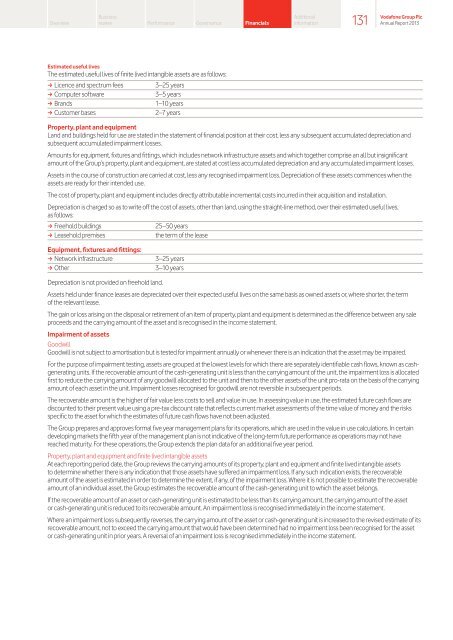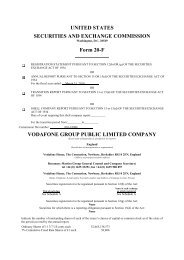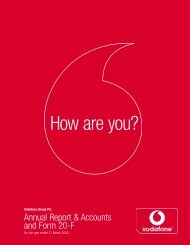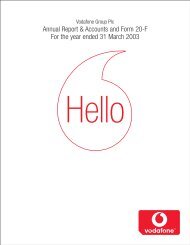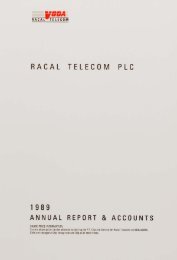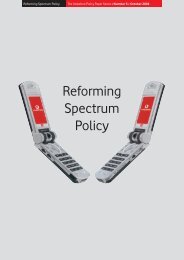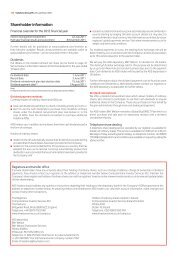The way ahead? - Vodafone
The way ahead? - Vodafone
The way ahead? - Vodafone
You also want an ePaper? Increase the reach of your titles
YUMPU automatically turns print PDFs into web optimized ePapers that Google loves.
Overview<br />
Business<br />
review Performance Governance Financials<br />
Estimated useful lives<br />
<strong>The</strong> estimated useful lives of finite lived intangible assets are as follows:<br />
a Licence and spectrum fees 3–25 years<br />
a Computer software 3–5 years<br />
a Brands 1–10 years<br />
a Customer bases 2–7 years<br />
Property, plant and equipment<br />
Land and buildings held for use are stated in the statement of financial position at their cost, less any subsequent accumulated depreciation and<br />
subsequent accumulated impairment losses.<br />
Amounts for equipment, fixtures and fittings, which includes network infrastructure assets and which together comprise an all but insignificant<br />
amount of the Group’s property, plant and equipment, are stated at cost less accumulated depreciation and any accumulated impairment losses.<br />
Assets in the course of construction are carried at cost, less any recognised impairment loss. Depreciation of these assets commences when the<br />
assets are ready for their intended use.<br />
<strong>The</strong> cost of property, plant and equipment includes directly attributable incremental costs incurred in their acquisition and installation.<br />
Depreciation is charged so as to write off the cost of assets, other than land, using the straight-line method, over their estimated useful lives,<br />
as follows:<br />
a Freehold buildings 25–50 years<br />
a Leasehold premises the term of the lease<br />
Equipment, fixtures and fittings:<br />
a Network infrastructure 3–25 years<br />
a Other 3–10 years<br />
Additional<br />
information<br />
Depreciation is not provided on freehold land.<br />
Assets held under finance leases are depreciated over their expected useful lives on the same basis as owned assets or, where shorter, the term<br />
of the relevant lease.<br />
<strong>The</strong> gain or loss arising on the disposal or retirement of an item of property, plant and equipment is determined as the difference between any sale<br />
proceeds and the carrying amount of the asset and is recognised in the income statement.<br />
Impairment of assets<br />
Goodwill<br />
Goodwill is not subject to amortisation but is tested for impairment annually or whenever there is an indication that the asset may be impaired.<br />
For the purpose of impairment testing, assets are grouped at the lowest levels for which there are separately identifiable cash flows, known as cashgenerating<br />
units. If the recoverable amount of the cash-generating unit is less than the carrying amount of the unit, the impairment loss is allocated<br />
first to reduce the carrying amount of any goodwill allocated to the unit and then to the other assets of the unit pro-rata on the basis of the carrying<br />
amount of each asset in the unit. Impairment losses recognised for goodwill are not reversible in subsequent periods.<br />
<strong>The</strong> recoverable amount is the higher of fair value less costs to sell and value in use. In assessing value in use, the estimated future cash flows are<br />
discounted to their present value using a pre-tax discount rate that reflects current market assessments of the time value of money and the risks<br />
specific to the asset for which the estimates of future cash flows have not been adjusted.<br />
<strong>The</strong> Group prepares and approves formal five year management plans for its operations, which are used in the value in use calculations. In certain<br />
developing markets the fifth year of the management plan is not indicative of the long-term future performance as operations may not have<br />
reached maturity. For these operations, the Group extends the plan data for an additional five year period.<br />
Property, plant and equipment and finite lived intangible assets<br />
At each reporting period date, the Group reviews the carrying amounts of its property, plant and equipment and finite lived intangible assets<br />
to determine whether there is any indication that those assets have suffered an impairment loss. If any such indication exists, the recoverable<br />
amount of the asset is estimated in order to determine the extent, if any, of the impairment loss. Where it is not possible to estimate the recoverable<br />
amount of an individual asset, the Group estimates the recoverable amount of the cash-generating unit to which the asset belongs.<br />
If the recoverable amount of an asset or cash-generating unit is estimated to be less than its carrying amount, the carrying amount of the asset<br />
or cash-generating unit is reduced to its recoverable amount. An impairment loss is recognised immediately in the income statement.<br />
Where an impairment loss subsequently reverses, the carrying amount of the asset or cash-generating unit is increased to the revised estimate of its<br />
recoverable amount, not to exceed the carrying amount that would have been determined had no impairment loss been recognised for the asset<br />
or cash-generating unit in prior years. A reversal of an impairment loss is recognised immediately in the income statement.<br />
131<br />
<strong>Vodafone</strong> Group Plc<br />
Annual Report 2013


